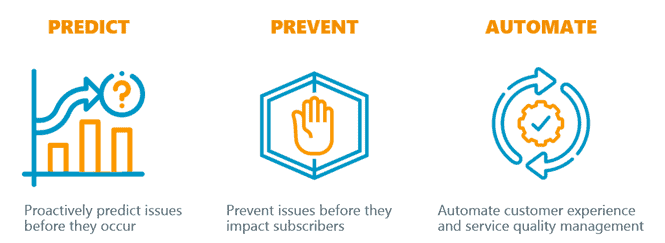Introduction: The importance of AI in enabling an intelligent network
Today’s networks are becoming more complex and resource-demanding. With the introduction of 5G advanced use cases such as edge and slicing, new frequency bands and spectrums, and the increased number of connected devices, operators must introduce automation to their network management process.
As customer expectations increase, operators spend significant amounts of time identifying service degradations and troubleshooting the network; that might shadow the efforts required for the transition to 5G, with its clear workload increase.
It is apparent that for 5G, the traditional telecom network operations and management model will not meet the increasing requirements needed to ensure the customer experience. Operators cannot continue relying on past manual processes and traditional monitoring tools. Adding to this is the operators will need to guarantee agreed-upon SLAs when supporting new use cases for vertical markets, including network slicing, edge deployments, and mission-critical communications services. To meet these and emerging requirements, an operator requires a much more intelligent and automated network.
By introducing AI into the network as part of an automated assurance strategy, operators can cut through the complexity, address the requirements of advanced use cases based on new technologies, optimize network performance, and enable network lifecycle automation. Furthermore, AI-driven insights will allow operators to manage their networks more effectively, being the key that will unlock the ability to offer quality, dynamic services at scale and deliver on the promise of 5G.
AI-fueled assurance is the key
AI is an essential building block for automating network operations and facilitating a closed-loop approach to assurance. An assurance solution with built-in AI/ML capabilities can automatically analyze multiple data sessions in real-time while collecting and correlating data for monitoring and assurance purposes. As a result, AI can reveal underlying network faults otherwise not identified or not identified fast enough in 5G networks.
Today, around 70% of operators’ time is spent looking for network issues and pinpointing the root cause. AI-driven assurance will significantly reduce this figure and free network teams to spend more time optimizing services and reduce mean time to resolution. In addition, for use cases like dynamic network slicing and predictive analytics, AI-based insights help identify traffic patterns and trends, which will create rules and policies that proactively prevent degradations and resolve issues.
As an operator, integrating an assurance solution with a built-in AI/ML engine will offer you the following key benefits:
- Predictive analytics that can forecast issues before they occur.
- Proactively identify performance issues across all services.
- Smartly monitor KPIs and KQIs using automated anomaly detection.
- Process and analyze immense amounts of data generated by the network, which no human can do.
- Solve complex pattern recognition problems and identify patterns over time and across different data sources.
- Correlate timeseries data from multiple sources (network events, event data records, and network packets) to gain smart insights.
- Troubleshoot from the KPI level down to the session/packet level.
- Optimize the customers’ quality of experience and overall quality of service in the most efficient way, accumulating expertise over time and enabling an intelligence data feed to reduce manual actions.

Assurance with a built-in AI/ML engine
Hence, deploying an AI/ML-driven assurance solution will improve overall network performance, provide higher efficiency levels, and an enhanced customer experience while supporting advanced 5G use cases.
AI/ML-driven assurance key features
An assurance solution with a built-in AI/ML engine should offer operators the following main features:
Modular architecture
Designed with the 5GC architecture that is cloud-native, the AI solution should offer a modular structure that can run on any cloud provider and is cost-effective with operators expected to deploy a multiple-cloud approach to 5G. Being cloud-native, the solution architecture comprises interchangeable microservices that can be easily updated or swapped out. These microservices can then be linked together to form an extended architecture, constituting a portion of the entire end-to-end monitoring architecture.
Such a solution should have a unique capability to receive and digest different inputs- Open API, OpenTracing, Kafka streams, raw packets, counters from Network Elements, DPDK, probes, Service-Based Interfaces (Subscribe/Notify, Request/Response methods)- Providing E2E independent monitoring of 5GC.
Moreover, it can be launched on-demand to investigate network issues on the fly. If service degradation is detected, the operator can spin up to perform in-depth, on-demand analysis, root-cause problems that affect the customer experience, and enable the operator to optimize network performance. Once service quality is restored, the operator can spin down the solution to free up valuable cloud resources and continue performing smart sampling on a percentage of the traffic.
Built-in ML models
Although an AI-driven assurance solution needs to include built-in ML models, the promise of AI means that the system is constantly learning, so new and updated ML models and algorithms are continually adapted and integrated into the solution on the fly. Best-in-breed ML algorithms such as Prophet for forecasting time series data (built and open-sourced by Facebook) or Amazon’s DeepAR+ or other CNN-QR algorithms that can be used based on each specific use case.
This flexible framework will allow you to Bring Your Own Analytics Container (BYOAC) using your ML algorithms as different algorithms fit different use cases and data sets. The solution can also use ML techniques like Generative Adversarial Network (GAN) for synthetic numeric and categorical time series generation so that learning can be applied without even the need for “real” network data.
Operators can use these ML algorithms for anomaly or outlier detection. An example of KPI-based anomaly detection is for release cause. An advanced algorithm is applied to identify anomalies in the release cause count between all network elements and the associated severity over time. It is thus removing ‘outliers’ from the release cause baseline.
The baseline outlier removal facilitates an accurate baseline prediction, improves the detection of network anomalies, and removes false positives. Also, in calculating a baseline, and a confidence area, it is possible to see points in time beyond the confidence area based on past data. These exceptions can be translated into additional alerts. Hence, by utilizing these AI-driven insights, engineers remain focused on handling critical customer-affecting issues rather than handling “alerts” that have no real effect on subscribers.
Continuous Integration and Continuous Deployment (CI/CD)
In the past, operators have experienced long assurance development cycles, which were directly connected to highly manual network monitoring and fault resolution. In today’s dynamic 5G networks, change is constant. Automated assurance solutions can be developed and deployed with zero downtime using continuous integration and continuous deployment (CI/CD) processes.
Each new assurance update results in automatic testing and verification to constantly evolve along with the network. Thus, the integration of CI/CD process adds a needed layer of operational transformation that directly connects with the network’s core architecture.
Making closed-loop automation a reality
Service assurance providers can offer telecom operators a “3-in-1” solution that leverages the same data collected from the network or 3rd party probes for three primary purposes. The first is to capture and correlate the data for assurance and monitoring purposes. The second is to use the data as an input for the AI solution and utilize the monitored telecom data and apply AI and ML for telecom-specific use cases such as automated root cause analysis and KPI-based anomaly detection.
Thirdly, assurance vendors can use this as a foundation for the Network Data Analytics Function (NWDAF) and transition to a closed-loop approach to network management. This can be used to implement NWDAF use cases according to 3GPP specifications in Release 15 and 16, as well as non-standard use cases specific to the operator. Together, these create a highly agile and customizable solution, fitting both operators’ needs as their 5G core functions are implemented, and the NWDAF function evolves.
An AI/ML-based assurance solution that combines it all
To conclude, by deploying a cloud-native assurance solution with built-in AI and ML capabilities, you will be able to:
- Analyze immense amounts of data generated by the network.
- Launch on-demand to investigate network issues on the fly.
- Use ML algorithms to detect hidden network anomalies in near real-time.
- Utilize a CI/CD pipeline for rapid deployment of change requests related to evolving 5G standards, including automatic testing and verification cycles.
- Utilize NWDAF to transition to a closed-loop approach to network management.
Summary
In conclusion, by introducing AI/ML-driven assurance, operators can cut through 5G complexity, address the requirements of advanced use cases based on new technologies, optimize network performance and enable network lifecycle automation. Furthermore, AI-driven insights will allow operators to manage their networks more effectively, being the key that will unlock the ability to offer quality, dynamic services at scale and deliver on the promise of 5G.
RADCOM ACE is our 5G automated assurance solution that seamlessly integrates into the 5G core as a Cloud-Native Function (CNF) to provide real-time subscriber analytics and E2E troubleshooting capabilities. Leveraging built-in AI/ML capabilities converts network lifecycle manual processes into automated practices, from planning to ongoing operation.
Being dynamic and fully integrated enables operators to take an on-demand, closed-loop approach to unlock the full potential of 5G and deliver on its advanced use cases.
To learn how to assure the lifecycle of your 5G network download our infographic.
This article is subject to RADCOM’s disclaimers regarding Forward-looking statements and general information under the links below:

